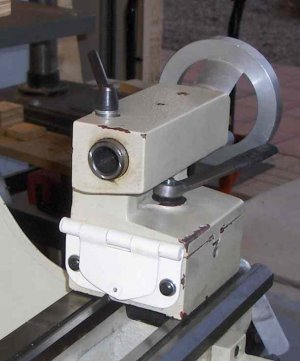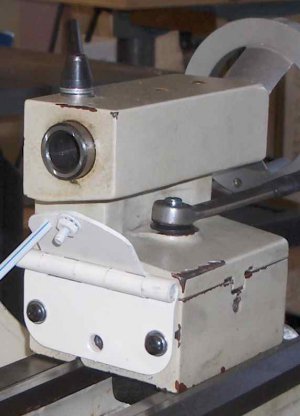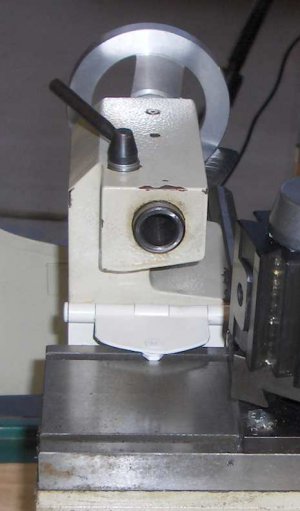-
Welcome back Guest! Did you know you can mentor other members here at H-M? If not, please check out our Relaunch of Hobby Machinist Mentoring Program!
You are using an out of date browser. It may not display this or other websites correctly.
You should upgrade or use an alternative browser.
You should upgrade or use an alternative browser.
Carriage Drilling Adapter
- Thread starter Hawkeye
- Start date
- Joined
- Jul 26, 2011
- Messages
- 4,142
It will help your carriage forces a lot if you drill a smaller hole first,so the flat,chisel end of the larger drill doesn't require as much force to push into the metal. You are exactly right: You can't feel the forces. When I start to drill with this setup,I'd keep an eye on the corner of the carriage to see if it shifts sideways a little bit,trying to twist. Use only very sharp drills and fine as possible feeds. Try feeding the carriage by hand and try to see how hard it is to feed the drill along.
Actually,you'd be just about as well off hand feeding the carriage,since with a quick motion,you can withdraw the drill anyway,with the carriage hand wheel. I'd use the drilling attachment in that manner,and forget power feeding. What you really wanted anyway was to not have to mess with cranking the tailstock back,and you have it with this attachment.
Don't forget either: The gear that engages the rack is a LITTLE gear. On an Asian machine,it likely is not heat treated. When I had a 12" Atlas,I think I had to replace that little gear,which was no larger than a quarter(25 cents). It was mounted on a 3/8" square teeny shaft,too,IIRC. SO,have mercy on the little gear!!
Actually,you'd be just about as well off hand feeding the carriage,since with a quick motion,you can withdraw the drill anyway,with the carriage hand wheel. I'd use the drilling attachment in that manner,and forget power feeding. What you really wanted anyway was to not have to mess with cranking the tailstock back,and you have it with this attachment.
Don't forget either: The gear that engages the rack is a LITTLE gear. On an Asian machine,it likely is not heat treated. When I had a 12" Atlas,I think I had to replace that little gear,which was no larger than a quarter(25 cents). It was mounted on a 3/8" square teeny shaft,too,IIRC. SO,have mercy on the little gear!!
- Joined
- Jun 17, 2011
- Messages
- 2,069
I'm not overly concerned about the strength of the Storebro. It isn't the heaviest lathe ever built, but it certainly isn't a hobby lathe. It has a 50mm diameter post on the compound that expands inside a close-fitting pocket in whatever toolpost you choose to mount. The post expands at the same time the toolpost block is being pulled down on the compound. I've never had the toolpost or the compound angle shift yet.
Having said that, there isn't much chance that I'll be power feeding a drill bit. I have raised the knee of my Victoria under power a couple of times in a drilling operation, but it is dancing around the limits of my comfort zone.
Having said that, there isn't much chance that I'll be power feeding a drill bit. I have raised the knee of my Victoria under power a couple of times in a drilling operation, but it is dancing around the limits of my comfort zone.
- Joined
- Feb 17, 2013
- Messages
- 4,417
Last June, I added a tailstock-to-carriage coupling to my 9x20 lathe. Mounted a simple door hinge to the tailstock, with a pin on the bottom of the moveable hinge leaf. To drive the tailstock with the carriage, lift the leaf, bring the carriage and tailstock together, and drop the pin into the T-slot of the cross slide. See photos. The middle hole in the hinge (and tailstock) provide clearance for the pin, allowing the moveable leaf to hang flat when not in use.
After using the system a couple times, I noted that the pin would sometimes ride up and out of the T-slot. Solved that by filing away some of the threads on the pin (a #10 screw), leaving the bottom 1/8" or so at full diameter. This hooks more securely into the T-slot.






After using the system a couple times, I noted that the pin would sometimes ride up and out of the T-slot. Solved that by filing away some of the threads on the pin (a #10 screw), leaving the bottom 1/8" or so at full diameter. This hooks more securely into the T-slot.






It will help your carriage forces a lot if you drill a smaller hole first,so the flat,chisel end of the larger drill doesn't require as much force to push into the metal. You are exactly right: You can't feel the forces. When I start to drill with this setup,I'd keep an eye on the corner of the carriage to see if it shifts sideways a little bit,trying to twist. Use only very sharp drills and fine as possible feeds. Try feeding the carriage by hand and try to see how hard it is to feed the drill along.
Thank you! I know it's been eight years, but I'm grateful for having finally found this and understood it.
I just tried carriage drilling, using an #3MT adapter in my QCTB for the same chuck I use in my tailstock. I used the finest feed on my lathe. I drilled 0.1" per pass clearing chips between passes, but thought that power feed would give nice even pressure and improve the quality of the feed. To release the power feed easily and not damage the carriage feed gears, I added momentary slight feed pressure with the handwheel while disengaging the carriage feed; that clearly worked.
I was pilot-drilling almost 5" through with a fresh 3/16" aircraft drill through 1117 CRS, and the hole did wander slightly (maybe .05"? I didn't measure). I didn't understand why it wandered until reading this quote.
I think I'll keep carriage drilling, but try only feeding by hand to have better feel, at least for pilot drilling.
(Also, I should probably make a spacer to replace my compound for when I don't need the compound, to increase rigidity, if I'm going to do this. I know that a lot of people consider that best practice and it's been on my to-do-someday list for a while.)
